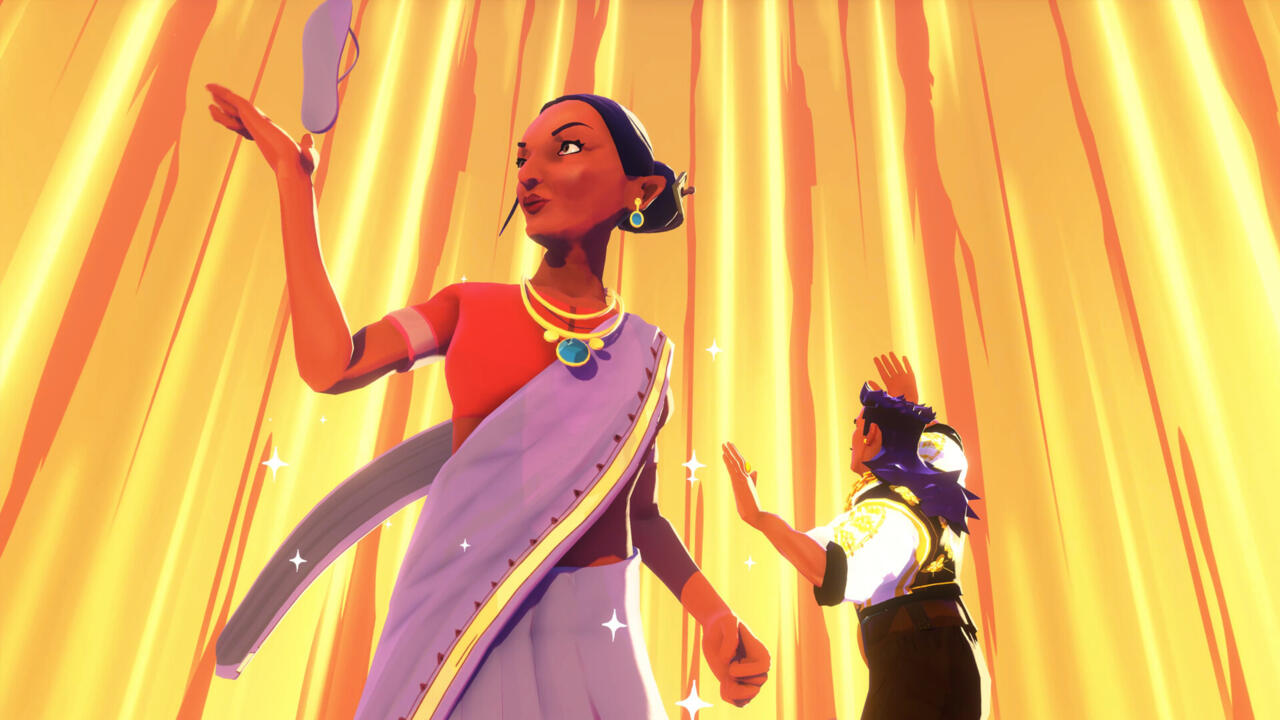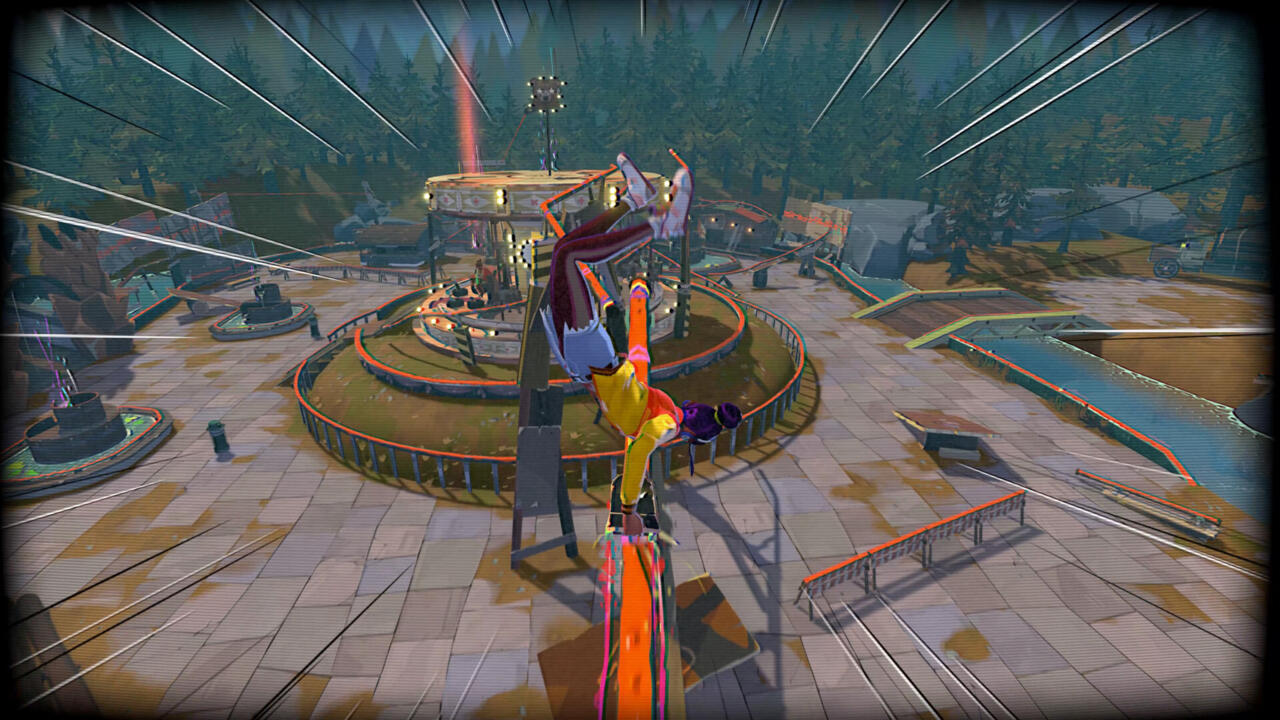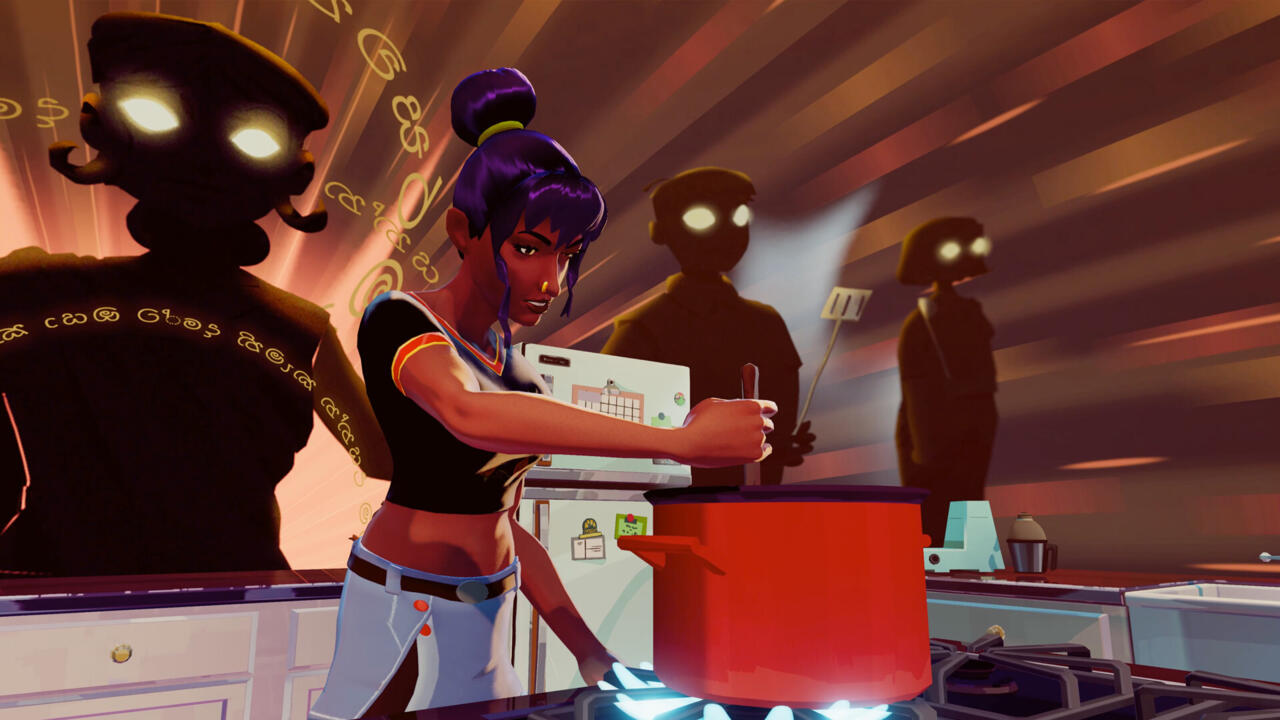At a glance, Thirsty Suitors is a game about revenge. Its story follows the recently heartbroken Jala Jayaratne, who returns to her hometown only to be relentlessly attacked by a league of evil exes. But it is also so much more than that. As the story progresses, we come to discover that none of these exes are evil per se, and Jala herself is incredibly fallible. She left scorched earth in all of her previous relationships in Timber Hills, and her only option now is to reconcile and take accountability with each of these exes. Her attempts to make good take the form of turn-based combat built upon RPG progression that has a unique flavor and is fun to engage with. There’s even a surprisingly enjoyable skateboarding mechanic. In so many ways, Thirsty Suitors is unique and creative, but when all is said and done, what makes a lasting impact is a personal, vulnerable, and culturally nuanced tale about making things right.
As previously mentioned, you will be fighting each of Jala’s exes throughout the game in turn-based combat, leveling up stats, learning new skills to make fights easier, and using summons that can be unlocked through sidequests or the main story. Each fight is a conversation, a puzzle, and a battle in one where the objective is to discover the weakness of an opponent through a process of trial and error. Once you’ve identified that weakness, you can inflict status ailments or deal additional damage to chip away at their health. The RPG mechanics and the process of exploring and exploiting weakness are presented as a back-and-forth between Jala and her interlocutor where old wounds are reopened and issues are hashed out until the dynamic between them evolves or resolves. This system manages to work in the foundational element of RPGs but cleverly rethinks it to also give it narrative weight. The trial and error process is one of picking dialogue options, and these can have an impact beyond the battle too. Make the right decisions and you’ll come up with a plan that’ll pinpoint the enemies’ weaknesses through taunts, so you can easily trounce them with the use of the correct skills.
Jala’s initial ambition and awareness of her wrongdoings are unique for the main character of an RPG, let alone one spearheaded by a queer South Asian woman. Jala conveys her self-awareness by internalizing that she is the one at fault in all of her previous relationships, which manifests in the game as a banter between herself and a narrator. The narrator is a voice she has conjured up that is reminiscent of her sister, Aruni, in looks, voice, and tone. This, it turns out, is also a way for Jala to grapple with her strained relationship with her sister while still having guidance internally. The dialogue between them had me laughing throughout the game’s 17-hour runtime. The snide, direct, and reassuring nature of this narrator figure allows Jala to convey her struggles effectively by presenting these challenges to another entity in a candid way. The Narrator offers the guidance she seeks throughout the game even though her actual sister avoids confronting Jala. Each of Jala’s exes also has a coping mechanism such as Irfan and what other characters call his “obsession with his cat” to the point of carrying his pet around wherever he goes.
Conversations with other characters, like family members or exes, give you different dialogue choices that will determine Jala’s stats and build, and will shape how a given narrative moment plays out. The three builds, or paths, available to the player are The Heartbreaker, The Star, and The Bohemian. Each of these determines whether Jala has increased attack rank, hit points, or Will Power (the latter is expended to use Taunts or Skills in combat).
Battles most commonly play out against the random suitors that Jala’s patti (grandmother) has sent to “win her love.” You can choose to start these battles as often or as little as you like by interacting with “Grift or Gift?” boxes. Grifts will be fights and gifts will earn you in-game currency without having to fight any suitors. The outcome of interacting with these “Grift or Gift?” boxes is randomized to maintain an element of surprise. It is still beneficial to have full health and/or Will Power before interacting with these boxes, however, since a battle may occur you’ll want to be prepared.

Thirsty Suitor’s battle system can be daunting at first, as it delivers a lot of information about its mechanics up front and expects you to retain it after the first fight, but there is a handy “Thirstpedia” in the options menu that is a helpful guide that will break down how the main combat mechanics work and the different ways to use them to Jala’s advantage. While the mechanics do eventually click into place, getting there may require referencing this guide instead of relying solely on the game’s brief tutorial.
Like many turn-based RPGs, combat is built on a system of weaknesses. In Thirsty Suitors, most weaknesses are determined by Mood, of which there are five: Thirsty, Raging, Shocking, Impressive, and Heartless. Different Taunts are used to figure out the Mood most effective to use on an enemy. If your chosen Taunt is effective on the enemy, it will inflict status effects on the opponent and earn you an extra turn that can be used to inflict Taunts on other enemies or land a powerful Skill on your now weakened target. It’s a familiar but satisfying system of establishing openings, exploiting them, and then repeating to build momentum.
In your first dozen or so battles, it does feel like a trial and error process to figure out the weaknesses of enemies. In other RPGs such as Persona 3, exploiting a weakness of an enemy type allows the player to retain that information on the specific weakness. But in Thirsty Suitors, this is not preserved since weaknesses are not as consistent from battle to battle. To decipher weaknesses, the dialogue from the initial battle introductions can help. For example, an enemy might start their battle introduction by pushing Jala for marriage. This little hint can serve as a clue to zero in on using a Thirsty or a Heartless Taunt with success. Almost all of the time these hints of enemy weaknesses are present. They are subtle, but a good way to provide a little assistance, and over time it becomes much easier to interpret how the dialogue is guiding you in battle. It is satisfying each time to exploit a weakness and receive additional turns to continue taunting other enemies or unleash powerful skills. I thoroughly enjoyed that I could have that “aha!” moment and gain the upper hand or turn the tables as soon as I figured out an enemy’s weakness.
When using these Taunts (or Skills), you will have to coordinate your button presses or directional inputs, inflicting the associated Mood for additional turns. In the same respect, timing button presses and directional inputs when your opponent is attacking allow you to mitigate damage from oncoming enemy attacks or Taunts. Thankfully, players can easily turn on options that automatically complete the onscreen prompts. It can get hectic when fighting enemies, so having these options readily available allows freedom to not worry about missing exact timings and helps with accessibility for those who need it. Altogether, Thirsty Suitor’s combat is very gratifying, especially when you manage to use the correct Taunt on an enemy. It feels great to properly use the game’s Mood system to your advantage and emerge victorious from a battle, especially when you manage to do it completely unscathed. Gameplay and narrative weight for dialogue choices come in the form of how much HP or WP is increased for the next bout. Certain plot points or conversations between characters can evolve and change depending on your choices as well.

Battles are zany, charming, and endearing, and the different taunts and skills are a big part of that too. I couldn’t help but smile at how absurd the combat can become by playfully poking at South Asian tropes, but also subverting them using the game’s RPG mechanics. Calling your own mother as a summon in these psychological battles to deal massive damage with her slipper is objectively hilarious and also, why not? Everything is fair game in these surrealist and fantastical fights, so calling your chappal-wielding mother to deal huge damage, even more so if you do it with an appropriate enemy and unlock secret dialogue interactions. The battle mechanics don’t change too much throughout the game, but the game’s evocation of South Asian tropes keeps things fresh so that each battle remains enjoyable, even if you’re not intimately familiar with South Asian culture.
Each of Jala’s exes has turmoil and trauma, all with their own coping mechanisms, and that trauma affects Jala in her own life separate from that relationship. For example, Diya is a lesbian and one of Jala’s exes. She was disowned by her family at a young age, leaving her with nowhere to go. Her parents, who live in the same town do not even acknowledge her. After their confrontation, Jala is forced to reflect on her own life and relationship with her family. She confronts her father and asks if her father would have disowned Jala in a similar fashion, which leads to an unexpected revelation about Auntie Chandra, who sees being a queer elder as a responsibility for the younger generation of Timber Hills. There is a thoughtful intersection between characters that highlights the domino effect of interactions, relationships, and behaviors. There are deep bonds and long histories that come to light, and many don’t even have Jala at the center of it all. It is impressive how the game explores themes of queer trauma, especially queer South Asian trauma, in excruciating detail, while not shying away from the reality that being queer is difficult for so many reasons.
Characters all have nuances and complexities boiling under the surface that speak to how they’ve been changed and I really admire that element of the writing. Andile trying to juggle his ancestors, roots, cultures, and traditions while being openly non-binary, but also subvert that they are not “small, petite” as the word “non-binary” tends to apply in white/western circles, for example. I can’t help but want to learn more about the people in this town and hear the stories that make each of them unique, to the extent that it’s disappointing when anyone isn’t given enough time to fully explore, as is the case for Andile.

I was also surprised by Thirsty Suitors’ main travel mechanic, skateboarding, which is both an easy and engaging way to get around. Outside of her home, Jala will automatically use her skateboard and she can jump on different guardrails, shred on benches, and hang off wires to do different tricks. By just holding down the trigger or changing the direction with the left analog stick when already on any of these objects, you will build up combo multipliers with different tricks or moves. You can freely hop around to different objects or run on the side of walls to stack up the combos. Hitting any of the denizens roaming around or any objects will drop your combo multipliers, so you will need to be aware of the surroundings and adapt to what is ahead. When you feel like finishing your extensive combo, there are certain objects such as the fountain in the middle of Downtown to total your points in a stylish showstopping manner. The game’s skating is intricate and well-crafted, with some of the challenges teaching you how to do more expert-level tricks. Between story objectives, I found myself getting sidetracked skating around Downtown or the Skatepark–not even by any specific available challenges, but rather by the hypnotic pleasure of trying new tricks and building up the combo multiplier or unlocking new characters to skate (you can skateboard as a dog that wears wings!). Online Leaderboards allow you to compete against your friends on challenges, giving you the extra push to do better or rank higher on the Leaderboards for bragging rights. Having a little message pop up that you have earned a new personal best or trumped one of your friends is a fulfilling feeling.
The game has a plethora of optional skateboarding activities and challenges that will grant you items or in-game currency, and there are several mandatory ones as well. However, there are accessibility options to autoskate, which alleviates the potential roadblock of the mandatory skateboarding challenges needed to progress the game’s story.
The last core mechanic of Thirsty Suitors is cooking. Jala can cook many different South Asian dishes and, like the game’s battle mechanics or the skating, you can easily turn on accessibility features to perfect the cooking segments, since they also require exact execution of on-screen prompts. Jala brings a pizzaz and oomph to cooking tasks that is enamoring to watch thanks to the excellent animation work on display. Simple tasks like washing her hands or shaking spices have her do flips, jumps, and stylish maneuvers around the kitchen, and it’s a delight to watch.
Cooking dishes is also an integral mechanic of the game with cooking done in a step-by-step fashion overseen by one of Jala’s parents, and I found myself creating the same meals again to choose different dialogue options. Outside of providing additional dialogue between Jala with her parents to discuss different topics such as marriage and life’s obstacles, or inquire about things Jala never knew about, the dishes you cook can be used in battle. The better you execute the cooking steps, the more approval (and heat) you will receive from your parents. Approvals add up, granting you bonus dishes to use in battle with stronger effects. Oothoappam will restore HP over time, for example, but Oothoappam+1 will restore more HP over time and temporarily decrease the damage taken.

Even though I didn’t use the accessibility options, having them available is most welcome. These accessibility features allow many different types of players to try a turn-based RPG such as this, and it is already such a rarity for games in this genre, with rapid button presses or circular motions, to offer these easily togglable features. It shows the care the developers placed not just on the game’s representation or storytelling, but the player too.
Like the animations, the game’s music is very complimentary to the presentation. The main battle theme against Patti’s suitors will be a track you will hear a lot, but I never tired of hearing it. My favorite tracks are the individual ones orchestrated from the game’s different boss battles, and as soon as you beat any boss you can use jukeboxes around Downtown to listen to specific tracks in your free time.
The cel-shaded art style and colorful environments really showcase the characters by uplifting their models. Each boss battle is filled with artistic flourishes. One boss battle will have backgrounds in pink with crystals and diamonds abound, like a royal kingdom. Another boss’ environment is ghoulish, dark, and vampiric like a graveyard. The environments and aesthetics very effectively highlight the qualities and vibe of the ex you’re fighting.
One of my favorite aspects of the game was the use of popular culture references. Hearing references to Neon Genesis Evangelion, The Shining, and other art but with a unique spin on really highlighting the game’s own allegories, analogs, and analogies. A non-playable character says they love Neon Genesis Evangelion because they “love giant mechs, but hate their dad,” which is an interesting way to explore the struggles of explaining to others who you are, and showing that art can be a perfect stepping stone to discovering that. These references also present Timber Hills as if it were a real place that is impacted by the influence of media and art we have in our world, making it all feel relatable as a result.
The way Thirsty Suitors meshes turn-based combat, cooking minigames, and a skateboarding simulator is a huge success. On paper, so many disjointed ideas don’t sound like they will work, but Thirsty Suitors brings it all together in impressive fashion. And it does so while also elevating and celebrating South Asian characters and their stories in a modern-day setting.
